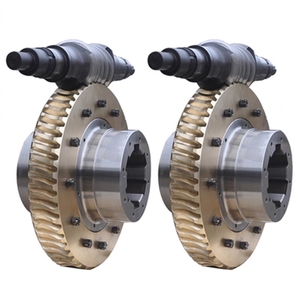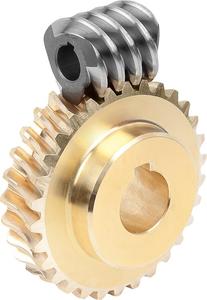(10746 products available)



































































































































































































A solid gear shaft taper is a machine element used to connect two rotating parts of a machine, typically at a fixed right angle. Meanwhile, its splines or teeth mesh with another set of teeth or splines. Gear shafts serve various functions in a machine, including power transmission, torque generation, and speed regulation. Below are some common types of gear shafts:
Helical Gear Shaft
A helical gear shaft has angled teeth that make it resemble a screw. The tooth angle allows for smoother and quieter operation as the teeth engage and disengage progressively. The gradual engagement also allows the gear shafts to carry heavier loads compared to spur gears. Additionally, helical gear shafts can operate at higher speeds.
Parallel Key Gear Shaft
A parallel key gear shaft has a key fitted in a keyway. The method creates a form of interference and intended fits to transmit torque between the two components. However, it does not allow for rotational or axial movability. Without movability, stress concentration between the gear shaft and the key can occur. If there is a high stress concentration, the gear shaft can break or be damaged. One of the solutions proposed is to create rounds and square keyways.
Flexible Gear Shaft
A flexible gear shaft consists of a driving end or outer casing, an inner cable, and a driven end or connector. The configuration allows for the connection of two parallel shafts while accommodating axial, radial, and angular misalignment. Moreover, it can absorb shock loads and reduce vibration in the system. Depending on manufacturing needs, a flexible gear shaft can be made from stainless steel, plastic, or aluminum.
Pinion Gear Shaft
The pinion gear shaft is usually smaller, and its main role is to mesh with a larger gear, called the bevel gear shaft. Together, they help transmit torque between shafts running at an angle to each other.
Spline Gear Shaft
The spline gear shaft has several teeth. It is a popular component in heavy industry applications, especially in the automobile industry. The shaft transmits torque between two rotating components and allows for constant angularity.
Materials
Solid gear shafts are typically made of strong materials like alloy steel and carbon steel. These materials can handle heavy use and pressure without breaking.
Sizes
Solid gear shafts come in different diameters and lengths to fit with various gear size requirements. The diameters can range from a quarter of an inch to several inches. The lengths can vary depending upon the specific needs of the machinery.
Connection Methods
Solid gear shafts use different connection methods to attach to gears solidly. Common connection methods include keys and splines. Keys fit into grooves machined on the gear and shaft for a tight fit. Spline connects through ridges and grooves that allow for a stronger meshing action.
Load Capacities
Load capacity indicates the maximum weight or pressure solid gear shafts can support while working. This measures in terms of torque, which is the twisting force produced when engines run. Some gear shafts are built to handle light loads, while others are made for heavy loads and industrial use.
Operating Temperatures
Operating temperature refers to the highest and lowest temperatures solid gear shafts can tolerate. They usually work in temperatures from -40 to 120 degrees Celsius. Some are designed with materials that withstand extreme heat, up to 200 degrees Celsius, so they don’t break down or get damaged easily.
Maintaining a solid gear shaft is important to keep it working well and prevent breakdowns. Regular maintenance helps identify any small problems early on before they turn into bigger issues that could cause major repairs or replacements. With consistent care, the gear shaft will last a long time and continue to perform its job effectively with minimal interruptions.
Routine Inspections
Regularly inspect the gear shaft visually. Look for any signs of wear like cracks, breaks, or damages. Check if the mounting bolts are tight and see if there are any leaks around the seals and gaskets. Do routine lubrication of grease or oil as per manufacturer instructions. Lubrication helps reduce friction between moving parts and lowers the risk of overheating. Clean the shaft periodically to remove dirt, debris, or grime buildup. Use a solvent that is approved and safe for the gears. Store spare shafts properly in dry places away from direct sunlight. This preserves their quality and protects them until ready to use.
Proactive Repairs
If any damages are found during inspections, promptly repair or replace the gear. Get the shaft aligned appropriately when reinstalling after any service. Misalignment can cause unnecessary damage over time. Make sure to follow all maintenance protocols and solid gear shaft care routines outlined by the manufacturer closely. Doing so will go a long way in extending the lifespan of the gear and maximizing its performance capabilities.
Industrial machinery
Solid gear shafts are widely used in various types of industrial machinery. They are typically found in power transmission systems, such as reducers, motors, and generators. Heavy-duty solid gear shafts with high load-bearing capacity are usually applied in complex and high-intensity industrial machinery.
Automotive industry
The automotive industry is another major application field for solid gear shafts. Solid gear shafts are usually the power transmission components connecting the engine with other parts. They play an essential role in ensuring the vehicle's smooth operation and driving performance. Usually, heavy-duty solid gear shafts (e.g., drive shafts) are applied to withstand high torque and carry heavy loads. For precision, light-duty solid gear shafts are used in the transmission and control system of the vehicle.
Aerospace application
In the aerospace industry, solid gear shafts are usually used as crucial components supporting power transmission. They are used in reducers, turbines, and engines. Solid gear shafts help to efficiently transmit the engine's power. Some solid gear shafts with high-precision and good stability are used in the guidance and control system of the spacecraft, ensuring the accuracy and reliability of attitude control.
Robotics field
Solid gear shafts are an essential component used to achieve the power transmission and movement of robots. They are usually applied in the joints and drives of the robot. Solid gear shafts help to realize the robots' flexible motion and high-precision control.
Marine industry
In the marine industry, solid gear shafts are widely used in ships and equipment. Whether in the power system of the ship, like propeller shaft, or in the reducer, solid gear shafts play an important role in transmitting power and ensuring operational reliability. High-strength solid gear shafts are usually adopted to meet the demanding requirements of use in harsh marine environments.
Wind power generation
As one of the crucial components of wind power generators, solid gear shafts are mainly used to connect the gearbox and generator. They realize the conversion and transmission of mechanical energy, and support the stable operation of the whole wind power generation system. Solid gear shafts have high strength and good durability to adapt to varying environmental conditions and long-term operation.
When buying solid gear shafts for resale or as business inventory, it is crucial to visit the right supplier. Focus on suppliers and manufacturers who provide customization options. The gears can be made in any dimension, circumference, diameter, weight, or size to fit the client's application.
Clients should also be able to customize the materials used for the solid gear shafts, such as aluminum alloy, Q235, stainless steel, nylon, ABS plastic, or any other material. Customization also includes coating options like galvanization, polishing, oxidation, zinc, brushed, or any other coating that is desirable or works for the application's function.
Before placing an order, it is good for the client to request samples. This gives the client a chance to inspect the product and commercial viability. It is also good to check packing details, bulk order discounts, shipping fees, and the safest and most affordable shipping method for the destination country. Client references and ratings should factor in when choosing a supplier. The client should choose a supplier with a solid reputation and response to the challenges faced by customers in terms of goods application, customization challenges, timely delivery, etc.
A wholesale buyer should settle for a supplier who is also a manufacturing partner. Apart from offering customization options, the supplier should have the means to produce large quantities quickly and without compromising quality. The solid gear shaft should meet international standards and, at the same time, bear the distinctive qualities of the client's brand.
Q1: Can solid gear shafts be repaired?
A1: Generally, if there are no significant damages like cracks, breaks, or severe warping, solid gear shafts can be repaired. Minor damages like nicks and dents can be removed through shaft grinding. The keyways and bearings can also be repaired or replaced if worn.
Q2: What are solid gear shafts often made of?
A2: Solid gear shafts are commonly made of carbon steel, alloy steel, stainless steel, and other materials. Nonetheless, solid gear shafts made of carbon steel are prevalent in many industries due to their high strength and durability.
Q3: What are the characteristics of solid gear shafts?
A3: Solid gear shafts are known for their strength, load-carrying capacity, shock resistance, torque transmission, reliability, and versatility. This makes them suitable for a wide range of applications in different industries.
Q4: What are the common signs of gear shaft damage?
A4: Damaged gear shafts can affect the function of the gears. Some common signs include unusual noises coming from the gear housing, grinding sounds, vibrations, and difficulties in shifting or engaging the gears.